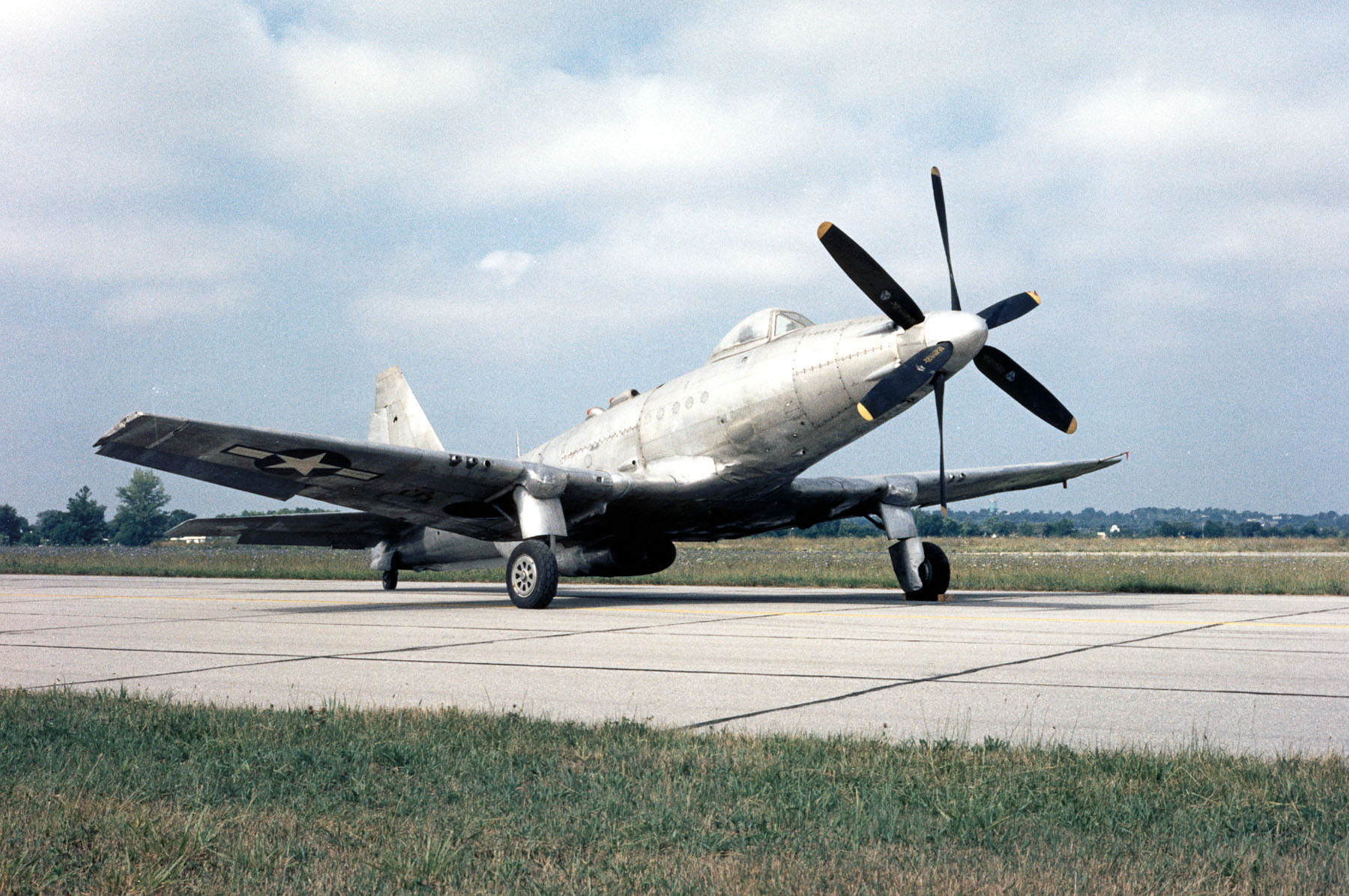- P-75 Eagle
infobox Aircraft
name =P-75 Eagle
caption =The last production P-75A (serial number 44-44553), now in the USAF Museum in Dayton, OH
type =Fighter
manufacturer =General Motors Corporation 
designer =
first flight =17 November 1943
introduced =
retired =
status =Cancelled6 October 1944
primary user =
more users =
produced =
number built =6
unit cost =
variants with their own articles =The General Motors P-75 Eagle was a
fighter aircraft for which theFisher Body Division ofGeneral Motors Corporation in September 1942 submitted a proposal to meet aUnited States Army Air Forces requirement for a fighter possessing an extremely high rate of climb. The proposal was for an aircraft that used the most powerful liquid-cooled engine then available, theAllison V-3420 (essentially a pair of 12 cylinderAllison V-1710 engines mated to a commoncrankcase ), and components from existing aircraft.Design and development
In October 1942, the contract for two
prototype s, designated XP-75, was signed with the Fisher Body Division of GM. The design concept was to use the outerwing panels from theP-51 Mustang , the tail assembly from the Douglas A-24 (SBD), and theundercarriage from theF4U Corsair in a general layout much as in theP-39 Airacobra with the engine located with thepropeller driven through an extension shaft. At an early design stage, however, P-40 Warhawk outer wing panels were substituted for the P-51 panels.In mid-1943, the need for long-range escort fighters became more urgent than fast climbing interceptors so a decision was made to order six more XP-75 airplanes modified for the long-range role. At this time an order for 2,500 production aircraft was also let, but with the stipulation that if the first P-75A was not satisfactory the complete order might be canceled.
At the time, General Motors was busy in several projects towards the war effort, including the mass production of several different aircraft types, including the
Grumman TBF Avenger . Some sourceswho claim that the P-75 was the result of a scheme to get General Motors out of being forced to buildBoeing B-29 Superfortresses; the P-75 project being a "high-priority" project to help GM avoid the added strain of Superfortress production.Operational history
Powered by a V-3420-19 twenty-four cylinder engine rated at 2,600 hp driving co-axial contra-rotating propellers, the XP-75 flew for the first time on
17 November 1943. The second XP-75 flew shortly thereafter, with all six long-range XP-75s entering the test program by the spring 1944. The test program brought up a number of deficiencies, including miscalculation of the fighter’s center of mass, failure of the engine to produce its expected power, inadequate engine cooling, highaileron forces at high speed, and poor spin characteristics. Redesigns were introduced into the long-range XP-75s including a modified tail assembly, newcockpit canopy, and a V-3420-23 engine that corrected most of the problems by the time the first P-75A Eagles entered flight test in September 1944.By this time, the Army Air Force decided to limit the number of combat aircraft types in production and not enter into large-scale production of new types that might not be available before the war ended. As the P-47N Thunderbolt and P-51D Mustang demonstrated excellent long-range capabilities, the production run of the P-75A Eagle was substantially terminated on
6 October 1944 . It was decided to use the five completed production aircraft for experimental work and development of the V-3420 engine. As a result of those events, the P-75A did not complete formal performance trials due to termination of the production contract.urvivors
There was at least one remaining XP-75 as of 1998. It was in an unrestored condition at the
National Museum of the United States Air Force ,Dayton, Ohio . [ [http://airpower.callihan.cc/HTML/Spotlight/P75.htm Pictures USAF Museum Dayton, OH] ]pecifications (Long Range XP-75)
aircraft specifications
plane or copter?=plane
jet or prop?=prop
ref= [Green 1961, p. 87.] and [Green & Swanborough 1978, p. 7.]
crew=One
length main=40 ft 5 in
length alt=12.32 m
span main=49 ft 4 in
span alt=15.04 m
height main=15 ft 6 in
height alt=4.72 m
area main=347 ft²
area alt=32.24 m²
empty weight main=11,495 lb
empty weight alt=5,214 kg
loaded weight main=13,807 lb
loaded weight alt=6,263 kg
max takeoff weight main=18,210 lb
max takeoff weight alt=8,260 kg
more general=
engine (prop)=Allison V-3420 -23
type of prop=liquid-cooled 24-cylinder double-Vee
number of props=1
power main=2,885 hp
power alt=2,150 kW
max speed main=433 mph
max speed alt=697 km/h
max speed more=at 20,000 (6,100 m)
range main=2,050 mi
range alt=3,300 km
ceiling main=36,400 ft
ceiling alt=11,100 m
climb rate main=4,200 ft/min
climb rate alt=21.3 m/s
loading main=39.8 lb/ft²
loading alt=194.3 kg/m²
power/mass main=0.21 hp/lb
power/mass alt=0.34 kW/kg
more performance=
armament=
* 6x 0.5 in (12.7 mm) wing mounted machine guns
* 4x 0.5 in (12.7 mm) fuselage mounted machine guns
* 2x 500 lb (227 kg) bombsee also
aircontent
related=similar aircraft=
see also=
lists=
References
Notes
Bibliography
* Green, William. "War Planes of the Second World War - Fighters (Vol 4)". London: Macdonald & Co. (Publishers), 1961 (Sixth impression December 1969). ISBN 0-356-01448-7.
* Green, William and Swanborough, Gordon. "WW2 Aircraft Fact Files: US Army Air Force Fighters, Part 2". London: Macdonald and Jane's Publishers Ltd., 1978. ISBN 0-354-01072-7.
* Winchester, Jim. "The World's Worst Aircraft: From Pioneering Failures to Multimillion Dollar Disasters". London: Amber Books Ltd., 2005. ISBN 1-904687-34-2.External links
* [http://www.nationalmuseum.af.mil/factsheets/factsheet.asp?id=2221 USAF museum P-75 Eagle factsheet]
Wikimedia Foundation. 2010.
